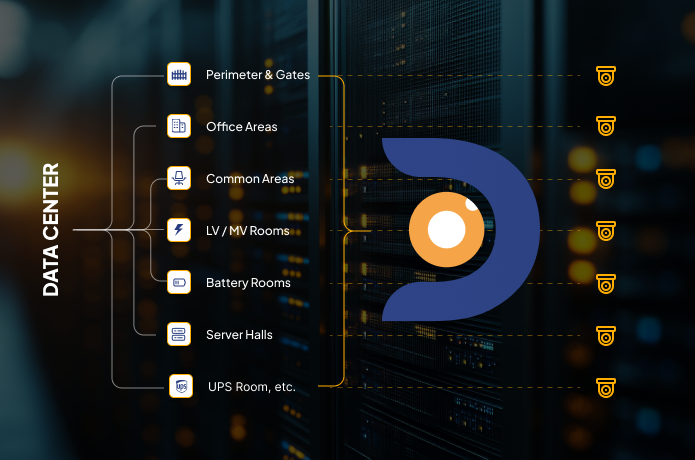Cloud-Based VMS
Cloud-Based VMS
Why AI-Enhanced Video Surveillance Matters For Data Centers

Everything runs on data – from the apps we use daily to the systems powering global industries. And behind it all are data centers, quietly doing the heavy lifting.
While these facilities are already equipped with strong physical and cybersecurity layers, the modern threat landscape demands more smarter, faster, and more proactive surveillance.
Drishticam, a cloud-based AI-powered video surveillance platform, designed specifically for high-stakes environments like data centers, is leading this transformation. It offers unmatched visibility, intelligence, and responsiveness to secure your most critical assets.
Why Traditional Security Isn’t Enough Anymore for Data Centers?
Data centers are high-value targets, facing increasingly complex threats from insider breaches to blended physical-cyber attacks. Traditional security systems like CCTV, ID cards, or human patrols are essential—but they’re reactive. They record what happens and rely heavily on humans to interpret, respond, and investigate. In a world where milliseconds matter, this approach just doesn’t cut it anymore.
Drishticam changes the game with proactive, intelligent surveillance. It leverages AI to monitor hundreds of video streams simultaneously, automatically detect anomalies such as unauthorised access, loitering, or tailgating, and trigger real-time alerts for immediate action. The platform is scalable, cloud-native, and designed to integrate seamlessly with existing infrastructure making it the ideal choice for modern data center security.
What Is AI-Enhanced Video Surveillance for Data Centers?
AI-enhanced video surveillance uses technologies like:
1. Computer vision to analyse visual data
2. Machine learning to recognize patterns and anomalies
3. Facial recognition for identity verification
4. Real-time alerts and automation to speed up responses
These systems can distinguish between a technician doing routine work and a suspicious person accessing off-limits areas. Over time, they learn normal behavior patterns and improve their ability to detect threats.
Complete Data Center Applicability
A Typical Data Center Consists Of These Items Which Can Be Address By Above Use Cases
Key Benefits for Data Centers
1. Real-Time Intrusion Detection: AI-powered systems constantly scan video feeds for unauthorised access, loitering, or movement in restricted zones. Unlike human guards or standard motion detectors, AI doesn’t get tired or distracted. It flags issues instantly and can even lock down areas automatically or notify security teams via mobile alerts.
2. Facial Recognition and Access Control: Combining facial recognition with AI allows data centers to verify identities more accurately. Even if someone has a valid keycard, AI can detect a mismatch between their face and stored credentials, reducing the risk of credential sharing or stolen badges. Bonus: AI can also detect tailgating when an unauthorised person follows someone through a secure door and immediately alert security staff.
3. Behavioural and Anomaly Detection: AI can analyse patterns of movement, timing, and frequency to learn what “normal” behavior looks like in each part of the facility. If someone suddenly spends an unusual amount of time near specific server racks or moves through the facility at off-hours, the system flags it.
This is particularly useful in detecting insider threats or breaches that wouldn’t be obvious to human monitors.
4. Environmental Risk Detection via IoT Integration: Many AI surveillance systems integrate with IoT sensors to monitor environmental factors such as:
(i) Temperature and humidity
(ii) Smoke or gas presence
(iii) Water leaks
(iv) Unusual vibrations or sounds
If something like a fire and smoke or HVAC failure begins, AI systems can spot warning signs early generate an alert immediately to prevent outages or equipment damage.
5. Automated Incident Response
AI-enabled platforms can automatically:
(i) Send alerts via SMS, Whatsapp, email, or dashboard
(ii) Activate sirens, IP Speakers
(iii) Trigger facility lockdowns
(iv) Generate and store video footage for compliance or investigation
This level of automation removes the delay between incident detection and action, potentially saving millions in downtime or damage.
6. Scalable Centralised Monitoring: Drishticam cloud-based AI video platform allow security teams to monitor multiple data centers from a central command center. AI helps filter out noise, only highlighting important events or anomalies that need human review.
This is critical for organizations with global operations, offering real-time visibility without requiring large on-site teams.

Real-World Use Cases
Colocation Facilities: In shared data centers where multiple clients rent space, AI surveillance helps ensure that access to each tenant’s area is strictly enforced. It also provides an audit trail for compliance and SLAs.
Enterprise and Hyperscale Centers: AI surveillance could be integrated with existing cybersecurity platforms to detect coordinated physical and digital threats. For example, if an unauthorised person accesses a rack and a login attempt occurs simultaneously, the system can correlate both and trigger an alert.
Edge and Remote Locations: Smaller data centers and edge facilities may not have full-time staff. AI surveillance provides autonomous monitoring, minimizing risks and alerting central teams to issues instantly.
Conclusion
Data centers are no longer just physical spaces filled with servers they are the nerve centers of the global economy. Their protection requires tools as dynamic and intelligent as the systems they support.
AI-enhanced video surveillance is not just an upgrade it’s a paradigm shift in physical security. It combines speed, accuracy, adaptability, and automation to create a new standard for monitoring and protecting high-value infrastructure.
Drishticam stands out as the right choice for data center surveillance. As a cloud-based, intelligent AI Video Management System (VMS), it provides real-time monitoring, predictive analytics, anomaly detection, and scalable deployment all essential for safeguarding sensitive infrastructure.
By adopting AI-driven systems today, data center operators can prepare for the increasingly complex threats of tomorrow securing not just buildings, but the digital lifeblood of our world.


